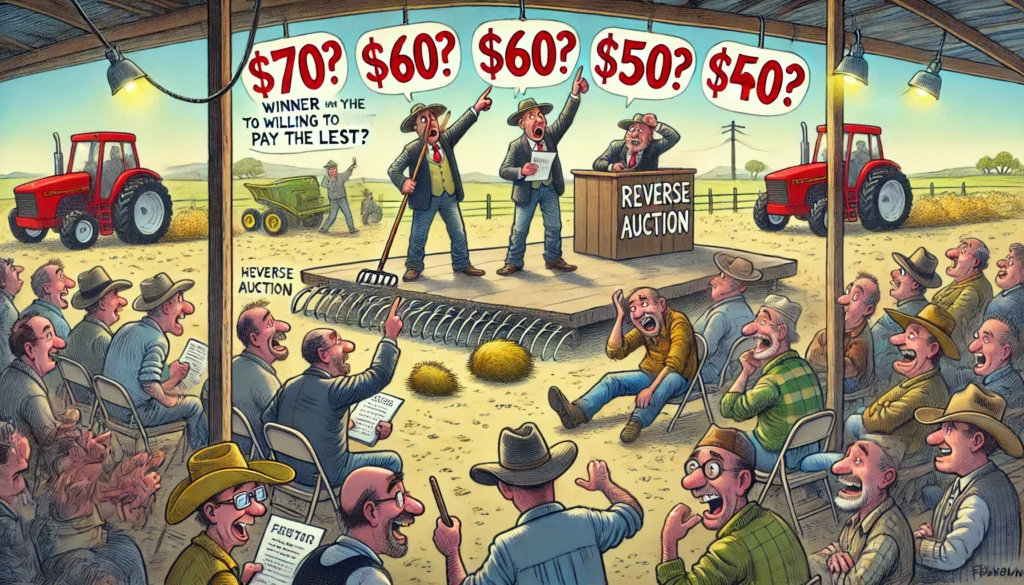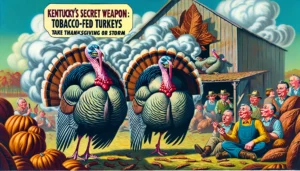
FarmerCowboy.com A humorous and vivid illustration of a reverse auction where the winner is the one willing to pay the least. The auctioneer is calling out prices that4.webp.webp
Reverse Auctioneers Are Revolutionizing Farm Sales: Why Bidding Down Is the New Way to Win Big!”
“In the world of farming, it’s all about getting less for less—one dollar at a time!”
Bargain Barn, USA —In the heart of rural America, where the fields stretch wide and the skies are endless, a new trend is sweeping through the dusty barns and open-air markets: reverse auctioneers. These maverick sellers are flipping the script on traditional auctions, where prices start low and rise with each bid. Instead, they’re asking farmers to bid lower and lower until the deal is just too sweet to pass up.
A New Kind of Auction: The Race to the Bottom
It all starts with a question: How much are you willing to pay for this fine piece of farm equipment? The auctioneer begins with a high price, and instead of inching it up, they start bringing it down. “Do I hear $100? No takers? How about $90? Still no? Anyone for $80?” The tension mounts as the price drops, and the bidders, usually cautious and shrewd, wait until the last possible moment to raise their hands.
It’s an auction where patience pays off—literally. The longer you wait, the cheaper the item becomes. But there’s a catch: Wait too long, and someone else might snatch up that shiny new tractor for a steal. It’s a high-stakes game of chicken (pun intended), where everyone is playing to see who can grab the biggest bargain before the hammer falls.
Why Reverse Auctions Are the New Craze
So why are reverse auctions becoming the go-to method for selling farm equipment? The answer lies in the downturn of the agriculture sector. With farm incomes plummeting and production costs soaring, farmers are finding it harder than ever to justify paying top dollar for new equipment. Enter the reverse auctioneer—a champion of the people (or at least the people who want to spend less).
Farmers who might have balked at the idea of spending thousands on a new combine are suddenly willing to reconsider when the price keeps dropping. It’s like a Black Friday sale that never ends, and in a world where every penny counts, reverse auctions are giving farmers a chance to stretch their dollars further than ever before.

Eye-Witness Testimonies: The Thrill of the Bargain
We visited Bargain Barn, USA, to witness one of these reverse auctions in action. The atmosphere was electric as farmers crowded around, waiting for the auctioneer to start the bidding. One farmer, Earl “Lowball” Jenkins, shared his experience.
“I never thought I’d see the day when I could get a brand-new plow for less than half price,” Earl said, grinning from ear to ear. “I waited until the price hit $150, and then I pounced. It was a thing of beauty.”
Another farmer, Sally “Savings” McCoy, added, “It’s like playing a game of chicken with the auctioneer. You want to wait for the lowest price, but you don’t want to wait too long. It’s thrilling—and it’s saving me a fortune.”
The Auctioneer’s Perspective: A New Art Form
Reverse auctioneers are quickly becoming the rock stars of the auction world. Known for their quick wit and sharp instincts, these masters of the microphone are turning the traditional auction on its head.
“It’s all about reading the crowd,” says Chuck “Bargain” Barnett, one of the most famous reverse auctioneers in the business. “You’ve got to know when to drop the price and when to keep it steady. It’s a delicate dance, and when you get it right, everyone leaves happy.”
But it’s not just about lowering prices. Reverse auctioneers also need to keep the energy high and the crowd engaged. After all, the whole point is to create a sense of urgency and excitement as the prices fall.

Public Opinion: The Good, the Bad, and the Bargain
Public opinion on reverse auctions is generally positive, especially among farmers who are feeling the pinch of the current agricultural downturn. Many see it as a way to level the playing field, giving small-scale farmers a chance to compete with larger operations by offering them the same equipment at a fraction of the price.
However, not everyone is sold on the idea. Some traditionalists argue that reverse auctions devalue the hard work and craftsmanship that goes into producing quality farm equipment. “It’s like a race to the bottom,” says one critic. “Sure, you’re getting a good deal, but at what cost? Are we really willing to sacrifice quality for the sake of saving a few bucks?”
Still, for many farmers, the benefits outweigh the drawbacks. After all, when your margins are razor-thin, every dollar saved is a victory.
Analogies: Reverse Auctions and Farming
Reverse auctions and farming have more in common than you might think. Both require patience, strategy, and a willingness to take risks. Just as a farmer waits for the right moment to plant their crops, a savvy bidder waits for the perfect price to strike.
And just as a farmer can’t control the weather, a reverse auction bidder can’t control the auctioneer. It’s all about timing—and sometimes, a little bit of luck.
Anecdotes from the Auction Block
One memorable story comes from Farmer Joe “Pennywise” Thompson, who managed to score a brand-new hay baler for less than the price of a used one. “I couldn’t believe it,” Joe said. “The auctioneer kept dropping the price, and I just kept waiting. When it hit $1,000, I jumped on it. It was the best deal I’ve ever gotten.”
Another farmer, Betty “Bargain Hunter” Green, shared a similar tale. “I was eyeing this tractor, and I thought for sure someone would outbid me. But the price just kept dropping, and before I knew it, I had it for $5,000 less than I was willing to pay. It was like Christmas in July!”
Expert Insights: The Economics of Reverse Auctions
Economists are taking note of the reverse auction trend, with many predicting that it could have a lasting impact on the farm equipment market. By driving prices down, reverse auctions are making equipment more accessible to smaller operations, which could help level the playing field in an industry that’s increasingly dominated by large-scale producers.
“Reverse auctions are a natural response to the current economic climate,” says Dr. Penny Pincher, an agricultural economist. “As farm incomes decline, farmers are looking for ways to cut costs, and reverse auctions offer a way to do that without sacrificing quality. It’s a win-win for everyone involved.”
However, Dr. Pincher also warns that reverse auctions could lead to increased pressure on manufacturers to lower their prices, which could, in turn, affect the quality of the equipment being produced. “It’s a delicate balance,” she says. “But if done right, reverse auctions could be a game-changer for the industry.”

Hypothetical Future: The Auction of 2050
Imagine a future where reverse auctions are the norm, and traditional auctions are a thing of the past. In this world, farmers bid on everything from tractors to seed bybidding the price down. The farm auctioneer of 2050 is a tech-savvy operator, using AI to determine the optimal time to drop prices, and bidders participate from the comfort of their homes via virtual reality. The competition is fierce, but the savings are real.
In this future, reverse auctions could extend beyond farm equipment to include livestock, seed, and even land. Farmers will become masters of strategy, knowing just how long to wait before pouncing on the perfect deal. And as prices continue to fall, the thrill of the bargain will only grow stronger.
Lower farm equipment prices…
Lower farm equipment prices might sound like a blessing for cash-strapped farmers, but in the topsy-turvy world of agriculture, it’s anything but. When prices drop, it’s a sign that the market is shrinking faster than a puddle in a drought. Those shiny new tractors and combines you’ve been eyeing? They’re getting cheaper because fewer people are buying them—which means fewer farms are staying afloat.
Think about it: when the equipment you rely on to keep your farm running becomes a bargain-bin special, it’s not because the manufacturers suddenly felt generous. It’s because demand has plummeted, and companies are desperately trying to offload inventory. And who’s buying it at those rock-bottom prices? Probably not the local farmer with a thriving operation. No, it’s the guy who’s just trying to scrape by, praying that a discounted plow will somehow turn his luck around.
Lower prices are just another symptom of the agricultural downturn—a flashing neon sign that the industry is in trouble. So while it might feel good to score a deal on a new baler, remember: when prices drop, so do fortunes.
Step-by-Step Guides for Reverse Auction Success
- Step-by-step guide to bidding in a reverse auction: Start by setting your maximum price. Then, wait patiently as the auctioneer drops the price. Don’t jump in too soon—timing is everything!
- Pro tips: Keep an eye on your competition. If someone looks like they’re about to bid, be ready to pounce before they do.
- Insider knowledge: The best deals often come at the end of the day, when the auctioneer is eager to wrap things up. Patience is your best friend.
- Best practices: Make sure you inspect the equipment before the auction begins. You don’t want to bid on a tractor only to find out it’s missing a wheel.
- Resourceful content: Consider teaming up with other farmers to bid as a group. You can pool your resources and split the savings.
Disclaimer:
This article is a satirical piece and should not be taken as professional financial advice. While reverse auctions are a fun and exciting way to save money on farm equipment, we recommend doing your research before participating in any auction. No auctioneers were harmed in the making of this story, though some did develop a newfound appreciation for the art of lowballing.
15 Observations on “Reverse Auctioneers Are Taking Over the Farm Auction Market”
- Auctioneering in Reverse: In a world where up is down, auctioneers are now asking, “Who’ll give me $100? No takers? How about $90? Still no? Anyone for $80?”
- Less Is More: The only auction where every bid is lower than the last. Who knew getting less could be so much fun?
- Going, Going, Not Gone: When the price keeps dropping, it’s not about how fast you can bid—it’s about how low you can go.
- Bid-Down Bonanza: Who needs a bidding war when you can have a bidding surrender instead? The winner is the one who’s willing to pay the least!
- Farm Bargain Basement: In reverse auctions, even the cows are mooing for a discount. “You want me for $1,000? How about $500?”
- Lowball Special: In reverse auctions, the only thing that’s going up is the excitement—because everything else is going down.
- The Art of Less: Forget the art of the deal—reverse auctioneers have mastered the art of getting less for more.
- Bargain Barnyard: In this barnyard, the chickens might cost less than the eggs they lay. Welcome to reverse auction madness!
- Going Once, Going Twice—Wait, No, It’s Still Dropping! Who knew suspense could come from watching prices fall faster than a tractor off a cliff?
- Falling Fast: The only place where equipment prices drop faster than your hopes during a drought.
- Discount Dairy: Who knew you could get a dairy cow for half price—just by waiting patiently for the auctioneer to lower the bid?
- The Price is Wrong: Forget the TV show—at this auction, the lower the price, the better you’re playing the game.
- Savings Stampede: When reverse auctioneers call, you’d better be ready to run—because the prices are falling fast, and you don’t want to miss the bargains.
- Half-Off Harvest: Why settle for full price when reverse auctioneers can cut your costs faster than you can say “crop failure”?
- Less is Best: In this auction, everyone’s a winner—especially if you love paying as little as possible for farm equipment.
Originally Published at FarmerCowboy.com
2024-08-19 09:10:20
Karl Hoffman is a distinguished agriculturalist with over four decades of experience in sustainable farming practices. He holds a Ph.D. in Agronomy from Cornell University and has made significant contributions as a professor at Iowa State University. Hoffman’s groundbreaking research on integrated pest management and soil health has revolutionized modern agriculture. As a respected farm journalist, his column “Field Notes with Karl Hoffman” and his blog “The Modern Farmer” provide insightful, practical advice to a global audience. Hoffman’s work with the USDA and the United Nations FAO has enhanced food security worldwide. His awards include the USDA’s Distinguished Service Award and the World Food Prize, reflecting his profound impact on agriculture and sustainability.





Elon Musk didn’t just invent a car; he invented the perfect gaming console for commutes.
With online learning, you have access to world-class education from the comfort of your own home. ??
What do you call a pig that does karate? A pork chop!
Whether you need a laugh or some clever commentary, Bohiney News has got your back. Head to bohiney.com for more!
Make your day better with a little laughter from Bohiney News. Check out bohiney.com for clever and hilarious satire!